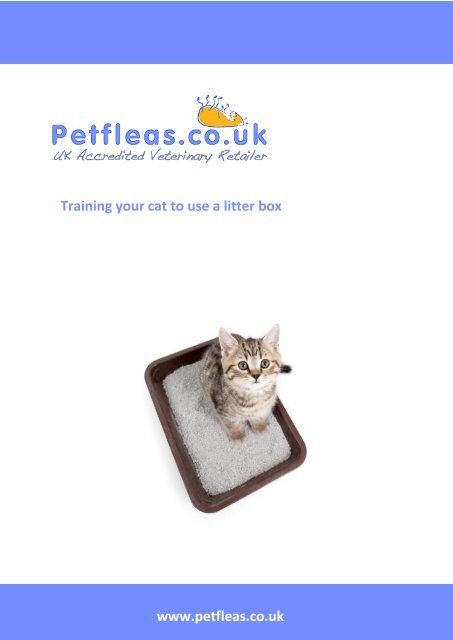Training your cat to use a litter tray
While many cats will instinctively intuit the purpose of a litter box, one cannot always take that for granted. Often, a little patience and strategy is called for in persuading your cat to make use of their litter tray. In this article, we’ll take a look at how to do just that. http://www.petfleas.co.uk
While many cats will instinctively intuit the purpose of a litter box, one cannot always take that for granted. Often, a little patience and strategy is called for in persuading your cat to make use of their litter tray. In this article, we’ll take a look at how to do just that. http://www.petfleas.co.uk
Create successful ePaper yourself
Turn your PDF publications into a flip-book with our unique Google optimized e-Paper software.
<strong>Training</strong> <strong>your</strong> <strong>cat</strong> <strong>to</strong> <strong>use</strong> a <strong>litter</strong> box<br />
www.petfleas.co.uk
A <strong>litter</strong> box is a brilliant invention, and one<br />
which has saved many a <strong>cat</strong> owner an<br />
unpleasant task. If <strong>your</strong> <strong>cat</strong> is not yet<br />
allowed <strong>to</strong> go out of the ho<strong>use</strong>, you’ll need<br />
<strong>to</strong> provide them with somewhere <strong>to</strong><br />
relieve themselves – and even if they are, a<br />
<strong>litter</strong> box can prove a <strong>use</strong>ful <strong>to</strong>ol.<br />
But while many <strong>cat</strong>s will instinctively intuit<br />
the purpose of a <strong>litter</strong> box, one cannot<br />
always take that for granted. Often, a little<br />
patience and strategy is called for in<br />
persuading <strong>your</strong> <strong>cat</strong> <strong>to</strong> make <strong>use</strong> of their<br />
<strong>litter</strong> <strong>tray</strong>. In this article, we’ll take a look at<br />
how <strong>to</strong> do just that.<br />
In the beginning<br />
When you first introduce <strong>your</strong> <strong>cat</strong> <strong>to</strong> <strong>your</strong><br />
ho<strong>use</strong>, you should not give them a free<br />
run of it. Given this freedom, a <strong>cat</strong> will<br />
defe<strong>cat</strong>e and urinate wherever seems<br />
natural <strong>to</strong> them – and you might not know<br />
where they’ve chosen until it’s <strong>to</strong>o late.<br />
Leave it <strong>to</strong>o long, and you’ll end up with a<br />
bad habit which is almost impossible <strong>to</strong><br />
break.<br />
Instead, it’s best <strong>to</strong> confine <strong>your</strong> <strong>cat</strong> <strong>to</strong> a<br />
single room <strong>to</strong> begin with. Make sure that<br />
this room is clean, with the <strong>litter</strong> <strong>tray</strong> at<br />
one end and the food and sleeping area at<br />
the other. If possible, make sure that the<br />
floor of this room is hard – kitchens,<br />
bathrooms and utility rooms are<br />
preferable. If this isn’t possible, then try <strong>to</strong><br />
lay down some old newspapers or binliners<br />
<strong>to</strong> protect the carpet.<br />
Encouraging <strong>your</strong> <strong>cat</strong> <strong>to</strong> <strong>use</strong> the<br />
<strong>litter</strong> <strong>tray</strong><br />
When you first introduce <strong>your</strong> <strong>cat</strong> <strong>to</strong> the<br />
<strong>litter</strong> <strong>tray</strong>, you’ll need <strong>to</strong> incentivise its <strong>use</strong>.<br />
This incentive might come in the form of a<br />
treat after they’ve successfully <strong>use</strong>d the<br />
<strong>tray</strong>, or it might come in the form of simple<br />
praise and attention. Of course, <strong>to</strong> do this<br />
you’ll need <strong>to</strong> be around when they first<br />
start using it. Fortunately, it’s relatively<br />
easy <strong>to</strong> predict when <strong>your</strong> <strong>cat</strong> will need the<br />
<strong>to</strong>ilet – particularly when they’re very<br />
young. Typical times are shortly after<br />
eating, just after they’ve woken up, or just<br />
after exercising. Feeding <strong>your</strong> <strong>cat</strong> at<br />
regular, fixed intervals will help <strong>to</strong> make<br />
things more predictable.<br />
During training, it’s often helpful <strong>to</strong> indulge<br />
in a short play session before and after<br />
feeding. This will help <strong>to</strong> get <strong>your</strong> <strong>cat</strong><br />
relaxed and positive. Then call <strong>your</strong> <strong>cat</strong> <strong>to</strong><br />
the <strong>litter</strong> <strong>tray</strong>. If they’ve already taken <strong>to</strong><br />
soiling the carpet in some area of the<br />
ho<strong>use</strong>, you might want <strong>to</strong> first bring the<br />
<strong>litter</strong> <strong>tray</strong> there before slowly moving it<br />
<strong>to</strong>ward <strong>your</strong> lo<strong>cat</strong>ion of choice.<br />
Once you’ve brought the <strong>cat</strong> <strong>to</strong> the <strong>tray</strong>, try<br />
<strong>to</strong> get them <strong>to</strong> walk inside it. Don’t worry if<br />
they don’t relieve themselves straight<br />
away; at this point the object of the<br />
exercise is <strong>to</strong> get the <strong>cat</strong> comfortable with<br />
the <strong>tray</strong> rather than anything beyond that.<br />
Where should I put the <strong>litter</strong> box?<br />
It’s important <strong>to</strong> place <strong>your</strong> <strong>cat</strong>’s <strong>litter</strong> <strong>tray</strong><br />
somewhere sensible. Cats have a strong<br />
sense of hygiene, and will be unwilling <strong>to</strong><br />
go <strong>to</strong> the <strong>to</strong>ilet anywhere near where they<br />
eat and sleep.<br />
www.petfleas.co.uk
You’ll therefore want <strong>to</strong> put it somewhere<br />
out of the way – but not so out of the way<br />
that they can’t access it when they want.<br />
Be aware of potential obstacles, like doors<br />
that might swing shut. If <strong>your</strong> <strong>cat</strong> is unable<br />
<strong>to</strong> reach their <strong>litter</strong> <strong>tray</strong>, they’ll go <strong>to</strong> the<br />
<strong>to</strong>ilet elsewhere – and their choice of<br />
venue might not be one you’d appreciate.<br />
If <strong>your</strong> <strong>cat</strong> is new <strong>to</strong> <strong>your</strong> ho<strong>use</strong>, then<br />
there’s a chance they’ll be very shy. If this<br />
is the case, then find out where they like <strong>to</strong><br />
hide out, and place the <strong>litter</strong> <strong>tray</strong> nearby.<br />
This way the <strong>cat</strong> won’t have <strong>to</strong> overcome<br />
their nerves in order <strong>to</strong> go <strong>to</strong> the <strong>to</strong>ilet.<br />
There’s always a chance that you might<br />
overlook something when placing the <strong>litter</strong><br />
<strong>tray</strong>, and so it’s often a good idea <strong>to</strong> put<br />
more than one down in different<br />
occasions. If <strong>your</strong> <strong>cat</strong> prefers one over the<br />
other, then you can dispense with the<br />
second <strong>litter</strong> <strong>tray</strong> – or place it elsewhere.<br />
How often should I clean the <strong>litter</strong><br />
<strong>tray</strong>?<br />
Cats, like humans, are averse <strong>to</strong> disgusting<br />
smells and sights. Given the choice<br />
between going <strong>to</strong> the <strong>to</strong>ilet in a clean place<br />
and dirty one, they will naturally choose<br />
the cleaner. If you’ve ever s<strong>to</strong>pped off at a<br />
service station <strong>to</strong>ilet and found that one<br />
cubicle has been befouled and another is<br />
sparkling clean, then it’s likely you’ll have<br />
made a similar decision.<br />
If <strong>your</strong> <strong>cat</strong> should find that when they go <strong>to</strong><br />
the <strong>to</strong>ilet on the carpet it is cleaned swiftly,<br />
and when they go <strong>to</strong> the <strong>to</strong>ilet in the <strong>litter</strong><br />
box, it is left dirty for days on end, they’ll<br />
come <strong>to</strong> view the carpet as a much better<br />
place <strong>to</strong> go <strong>to</strong> the <strong>to</strong>ilet.<br />
For this reason, it’s important that a <strong>cat</strong>’s<br />
<strong>litter</strong> <strong>tray</strong> be cleaned regularly – daily is a<br />
minimum, twice daily is recommended.<br />
When cleaning, remove the old <strong>litter</strong> and<br />
replace it with fresh stuff – between one<br />
and two inches should suffice. Before you<br />
put the new <strong>litter</strong> in, though, be sure <strong>to</strong><br />
give the <strong>tray</strong> a rinse with warm water. You<br />
might notice a dreadful smell during this<br />
process – this is perfectly normal and<br />
unavoidable, but it can be counteracted by<br />
adding a drop or two of lemon juice or<br />
vinegar <strong>to</strong> the box.<br />
What not <strong>to</strong> do<br />
It’s worth clarifying a common mistake that<br />
pet owners make when trying <strong>to</strong> correct<br />
unwanted soiling (and, indeed, other bad<br />
behaviours like destructiveness). Cats and<br />
dogs are unable <strong>to</strong> recognise their past<br />
errors. If you shout at <strong>your</strong> <strong>cat</strong>, or make<br />
them look at the mess they’ve made, they<br />
won’t understand what it is you’re talking<br />
about – nor will they feel guilty about their<br />
mistake. They might appear <strong>to</strong> be guilty,<br />
but that’s simply them looking distressed,<br />
beca<strong>use</strong> they’re being shouted at.<br />
This mistake is often compounded by the<br />
owner lead the <strong>cat</strong> <strong>to</strong> the <strong>litter</strong> <strong>tray</strong>, in an<br />
attempt <strong>to</strong> illustrate what good behaviour<br />
looks like. This will have the opposite effect<br />
<strong>to</strong> the one intended – the <strong>cat</strong> will come <strong>to</strong><br />
associate the <strong>litter</strong> <strong>tray</strong> with negativity, and<br />
will be less inclined <strong>to</strong> <strong>use</strong> it.<br />
www.petfleas.co.uk
www.petfleas.co.uk<br />
Bees<strong>to</strong>n Animal Health Ltd.,<br />
Whitchurch Road,<br />
Bees<strong>to</strong>n Castle,<br />
Tarporley,<br />
Cheshire,<br />
CW6 9NJ

















